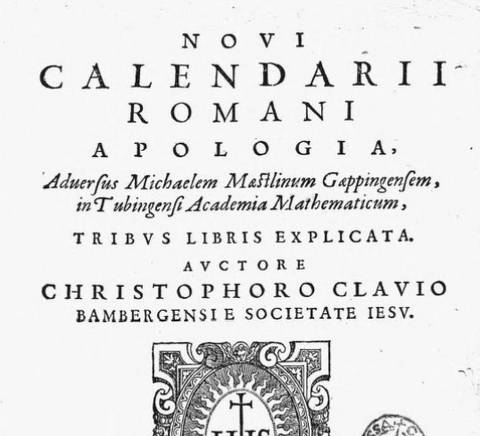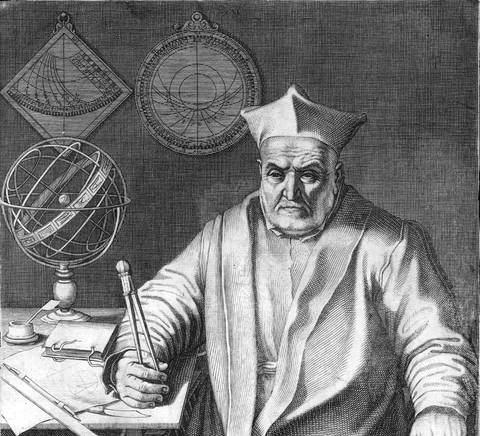La pieza de Noviembre
Novi calendarii romani apologia, adversus Michaelem Maestlinum Gaeppingensem… , de Cristóbal Clavio, SJ
Vestíbulo del edificio B de Cantoblanco

En la pieza del mes de noviembre, dedicada al Mes de la Ciencia, presentamos la obra de Cristóbal Clavio, SJ, Novi calendarii romani apologia, adversus Michaelem Maestlinum Gaeppingensem…, impresa en el Colegio Romano en 1588, en formato de 8º, con encuadernación en pergamino y cuya portada incluye el monograma de la Compañía de Jesús. En ella, el célebre científico jesuita expone de forma exhaustiva los fundamentos astronómicos y matemáticos de la reforma del calendario, defendiendo su legitimidad teórica y práctica y explicando con precisión sus implicaciones técnicas y litúrgicas. Esta obra constituye un hito tanto en la historia de la ciencia como en el estudio de la influencia jesuítica en la modernización astronómica y en el debate intelectual de la Europa postridentina.


Cristóbal Clavio, SJ (1538-1612), ingresó en la Compañía de Jesús en 1555 y pronto destacó por su excepcional talento matemático. Llamado a Roma para enseñar en el Colegio Romano —centro de referencia internacional de la renovación científica y matemática impulsada por los jesuitas— defendió con determinación la incorporación de las matemáticas como disciplina esencial en la formación académica y religiosa, y redactó tratados que establecieron estándares didácticos seguidos en universidades de toda Europa.

Su intervención en la reforma del calendario, promovida por el papa Gregorio XIII, constituye su legado más perdurable. Participó directamente en la corrección de la desviación acumulada por el calendario juliano, ajustando el cálculo del año solar y suprimiendo días para lograr una mayor precisión astronómica. Desde 1582 se convirtió en el principal defensor del nuevo calendario gregoriano frente a la comunidad científica internacional y a las objeciones del mundo protestante, manteniendo un activo intercambio epistolar con figuras como Galileo Galilei. Reconocido en su tiempo como el astrónomo más prestigioso de Europa, sus manuales universitarios se utilizaron durante siglos. Entre sus discípulos se encuentra Matteo Ricci, SJ, quien tradujo sus obras al chino y contribuyó decisivamente a la difusión de la matemática europea en Asia.

Novi calendarii romani apologia, adversus Michaelem Maestlinum Gaeppingensem… (Roma, 1588), no solo refleja la erudición y precisión científica de Clavio, sino que simboliza el papel decisivo de la Compañía de Jesús en la articulación entre ciencia y fe en el siglo XVI. Su defensa del calendario gregoriano supuso un punto de inflexión en la unificación del tiempo en Occidente y dejó una huella que, más de cuatro siglos después, sigue regulando nuestra manera de medir el año.
---
In the November “Piece of the Month,” dedicated to Science Month, we present the work of Christophorus Clavius, SJ, Novi calendarii romani apologia, adversus Michaelem Maestlinum Gaeppingensem… (Rome, 1588). In it, the celebrated Jesuit scientist thoroughly lays out the astronomical and mathematical foundations of the calendar reform, defending its theoretical and practical legitimacy and explaining in detail its technical and liturgical implications.
This work represents a milestone both in the history of science and in the study of Jesuit influence on astronomical modernization and on intellectual debate in post-Tridentine Europe. Christophorus Clavius, SJ (1538–1612), entered the Society of Jesus in 1555 and soon stood out for his exceptional mathematical talent. Called to Rome to teach at the Roman College — an international reference center for the scientific and mathematical renewal promoted by the Jesuits — he vigorously championed the inclusion of mathematics as an essential discipline in academic and religious training, and authored treatises that established instructional standards followed by universities throughout Europe.
His involvement in the calendar reform promoted by Pope Gregory XIII remains his most enduring legacy. He took a direct role in correcting the accumulated deviation of the Julian calendar, refining the calculation of the solar year and eliminating days to achieve greater astronomical precision. From 1582 onward, he became the foremost defender of the new Gregorian calendar before the international scientific community and against Protestant objections, maintaining a lively correspondence with figures such as Galileo Galilei.
Recognized in his time as Europe’s most prestigious astronomer, his university textbooks were used for centuries. Among his disciples was Matteo Ricci, SJ, who translated his works into Chinese and played a decisive role in spreading European mathematics in Asia.
Novi calendarii romani apologia, adversus Michaelem Maestlinum Gaeppingensem… (Rome, 1588) not only reflects Clavius’s erudition and scientific precision, but also symbolizes the decisive role of the Society of Jesus in bridging science and faith in the 16th century. His defense of the Gregorian calendar marked a turning point in the unification of time in the West and left a legacy that, more than four centuries later, still governs how we measure the year.
Créditos
Texto y selección bibliográfica:
Dña. Blanca Herranz Vírseda
Fondo Antiguo del Servicio de Biblioteca de la Universidad Pontificia Comillas
Descripciones bibliográficas:
Grupo de catalogación de la Biblioteca de la Universidad Pontificia Comillas
Cartelería:
Dña. Blanca Herranz Vírseda
Fondo Antiguo del Servicio de Biblioteca de la Universidad Pontificia Comillas
Diseño Web:
D. Ángel David Álvarez Mendoza
Dña. Daphné Vidalie
Grupo de Visibilidad del Servicio de Biblioteca de la Universidad Pontificia Comillas
Las imágenes utilizadas están libres de derechos y han sido obtenidas de Pixabay https://pixabay.com y Wikimedia Commons https://commons.wikimedia.org.
